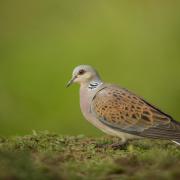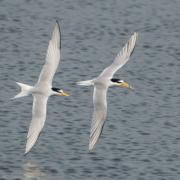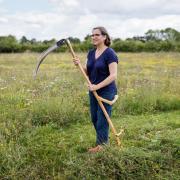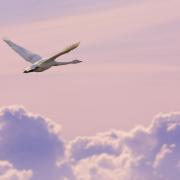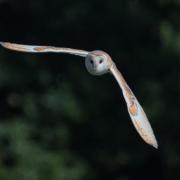David Falk of discover Suffolk takes to the platforms across Westwood Marshes to wonder at ther wildlife near Walberswick
David Falk of discover Suffolk takes to the platforms across Westwood Marshes to wonder at ther wildlife near Walberswick
A few miles north of the village of Westleton, past its quaint village hall and pleasant village green, is the wonderfully and appropriately named Newdelight Walks. The Walks are open heathland and sit adjacent to the intriguingly named Lumphall Walks and alongside the expanse of Dunwich Forest. It is here I find myself one cold, overcast, late winter’s day.
Booted up and equipped with binoculars I make my way along a sandy track to find a small plaque denoting one of Suffolk’s long distance paths: the Sandlings Walk. The waymarker symbol is a nightjar and although I doubt I’ll see one of these today, I take it as a good omen for things to come.
The path splits into three: left for the Sandlings Walk, right for Dunwich Forest, but I want neither and select the middle option. It offers no obvious destination, but I know this route well and as I make my way past fenced-in grazing Dartmoor ponies, I step on to a boardwalk that leads for over a kilometre through a quite mystical landscape.
My objective today is to seek out wildlife in one of Suffolk’s most outstanding locations – Westwood Marshes, Britain’s largest reed bed: a vast open landscape under an enormous sky. And this is a walk of changing characteristics, from wet woodland to birch coppice to freshwater marsh to sandy tracks, past remnants of windmills and expansive views along Suffolk’s heritage coast.
The boardwalk provides a dry platform through a strange landscape. Trees emerge from a waterlogged world creating perfect reflections of skeletal shapes, bare bark and angled limbs. It’s a weird, magical land, mosses adorn every tree, fungi grow in every place, and fallen trees seem to rejuvenate, pushing new growth from seemingly dead wood.
Scanning the woodland I see great, blue and long tailed tits skit about. Robins, chaffinches and wrens dart across the boardwalk. A pheasant makes a throaty call from the undergrowth. And a goldcrest dances playfully amongst the branches. It moves fast, stopping just long enough for me to admire the beautiful gold streak above its eyes.
The boardwalk reaches an area of neatly arranged grass tufts, a blanket of hair beneath a canopy of activity. I see a treecreeper spiralling its way up a tree. A greater spotted woodpecker bounds off its hole-pecked home and high above crows squawk, jackdaws chatter and wood pigeons flap noisily.
The boardwalk drops me in a small coppice of silver birch trees – it appears an artist has arranged them carefully creating a pattern of photo opportunities. And just beyond the walk, I enter the reedbeds of Westwood Marshes and leaving trees behind, the sky opens up with impressive views towards the most Suffolk of all coastal villages – Walberswick.
I set my sights on a flock of birds, shape-shifting across the sky. Fieldfares, ‘clacking’ like wind-up toys. The reedbed walk enters small clumps of trees, nature’s own bird hides, and excellent cover for watching these seasonal visitors. Blackbirds feed fearlessly along the path, unafraid of my presence, and somehow seem less familiar than at home, slightly more colourful and a bit more exotic.
Westwood Marshes is one of the best locations for marsh harriers and I am not disappointed. A solitary bird floats effortlessly, hugging the reed line, searching for prey. On the other side of the marsh, it is mirrored by a heron. This is one of the best locations in Suffolk for seeing these birds and their respective cousins: hen harriers and bitterns. It’s a wilder experience than the other bird watching site just down the coast: less busy and a break from civilisation.
The highlight comes as I near the iconic now derelict 18th century windmill. It stands lonesome amongst the reeds, changing its appearance with the mood of the sky. As I approach, a movement catches my attention and I turn to see three bearded tits. One of the most beautiful birds I’ve ever seen: caramel bodies, silver fronts and those name-giving sharp black tears below each eye, their beards. In turn, they climb to the top of a reed, their weight bending the head over, and then in an acrobatic upside down position, feed on the seeds. It’s a treasured moment.
I’ve covered just four miles in almost three hours, and make Walberswick for lunch before retracing my steps, stopping a while to watch cormorants out at sea, a little egret in the marshes, a fleeting glimpse of a sparrowhawk in the copse, and watch two muntjac deer stepping lightly in the wet woodland.
Back at Newdelight Walks, I reflect on a most delightful day.”
Before you go...
Key facts: Newdelight Walks and Westwood Marshes
Info: Not far from the A12, south of Blythburgh yet north of Westleton, Newdelight Walks have paths which lead you to the coast to the east through Fen Covert or to the Sandlings long distance path down south to Dunwich Forest. For more information, visit Suffolk County Council’s countryside website, www.discoversuffolk.org.uk.
Parking: There is a free car park on the B1125 at the junction with the road to Dunwich.
More mapping: OS Explorer No. 231
Four-legged friends: Newdelight Walks are open all year with dog restrictions until the end of August.
Comfort zone: All a bit rural for on-site facilities I’m afraid, but in Walberswick are public conveniences and places to restore and refuel during your outing.
DID YOU KNOW?
The Sandlings Way stretches some 60 miles between the eastern fringes of Ipswich and Southwold, linking the remaining fragments of the stunning Sandlings Heaths. You’ll find details of this and Suffolk’s other long distance paths such as the Mid and Suffolk Coast Paths, the Stour Valley Path, The Angles Way and the Icknield Way at www.discoversuffolk.org.uk

















